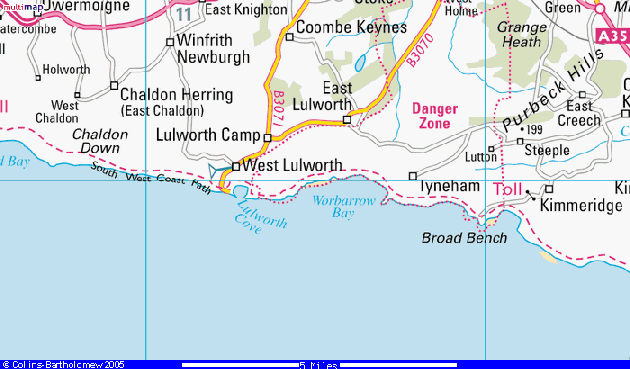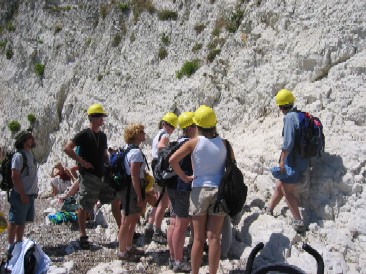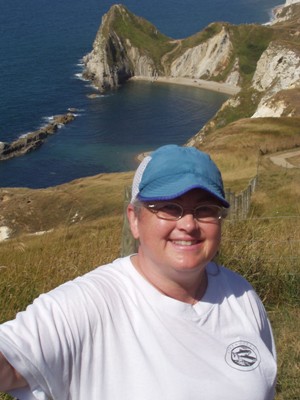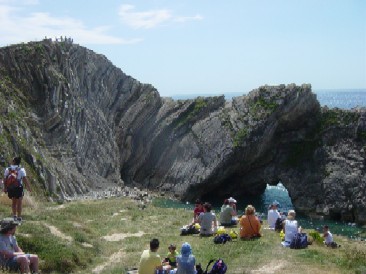The Real Jurassic Park: Geological Explorations in Southwest England
University of Washington, Tacoma
TESC 417: Summer 2006
The Real Jurassic Park: Geology field course along the south coast of England (TESC 417)
Home
Location: Lulworth Cove
Introduction:
July 30, 2006---This was our third day in the field and we saw some of the most spectaular sights of our trip. We visited Lulworth Cove, Durdle Door and Stair
Hole--this was the photo opportunity of the trip and everyone's cameras were clicking away.
Detail Map:

Highlights:
Lulworth Cove is considered the beauty of the Purbeck Coast--it lies at the far west end of the Isle of Purbeck. The sweeping views and incredible rock formations
are a result of the power of the sea on the rocks and their difference in resistance. Lulworth is a perfectly shaped horseshoe bay and one of the most famous features on the
Jurassic World Heritage Site.
Stair Hole is an additional bay that has formed next to Lulworth Cove. Collapsing caves and arches have
revealed the complex folds formed by earth movements that happened in the period during which the Alps were formed.
Durdle Door is another spectacular and popular site at Lulworth. It is located a mile west of the cove and is a perfect coastal arch--the rocks are tilted to the point that they are
almost vertical. The limestone that was onced a barrier is close to being destroyed. (Brunsden, 48-49)
 Descent to Durdle Door
Descent to Durdle Door
Synopsis of Area:
Lulworth Cove was formed when a stream breached the hard vertical layer of Purbeck limestone, Wealdon, greensand and chalk which acted as a barrier to the sea. The clays behind it were then hollowed out.
The rocks in the cave date back to the Cretaceous and Jurassic age--between approximately 65 - 150 million years ago.
The formations can be thought of in stages:
Stage 1: The stream started to breach the resistant Portland Limestone. Stage 2: The sea started to erode the softer Wealden Beds
that were located behind the limestone. Stage 3: The bay widened as the Wealden rocks were eroded. Stage 4: The chalk at the back of the cave kept it from
eroding further.
 The class studies chalk at Lulworth Cove
The class studies chalk at Lulworth Cove
Summary:
Sunday morning brought us good weather and an exciting day trip to Lulworth Cove, Durdle Door and Stair Hole. We all seemed to be getting accustomed to the 7:00 a.m.
wake-up time and the good hearty breakfast at Lesson House. We piled into the van with pick hammers and helmets, ready to explore and dig away at the chalk formations.
It was a healthy hike up the steep ridges that brought us up to Durdle Door at Lulworth Cove but well worth it. We were treated to spectacular views of the white cliffs against
the amazingly blue water. Cameras were clicking as we knew this was surely one of the best photo opportunities of the trip. Durdle Door was an awesome sight with
its graceful natural arch posed against the sea. Lulworth Cove is an almost perfect horseshoe bay with chalk exposed cliffs and low grasses covering the top of the
cliffs. Since there weren't any trees or bushes to block the view, we could see the beautiful scenery for miles. (Brunsden, 48-49)
 Cheryl enjoying the view at Lulworth Cove
Cheryl enjoying the view at Lulworth Cove
We enjoyed lunch at Stair Hole which was another spectacular location. We ate our lunch and watched swimmers and divers maneuver the arches and rock formations.
Some of us took a well-deserved nap while others got their feet wet in the ocean.
We continued to walk the beaches and search for fossils and rock formations. The picture-taking was endless. Then we were back to the van and headed for Lesson House to clean up
for dinner. After dinner, we congregated in the classroom to hear about projects and go over the next day's itinerary. After class was free time--there was no problem finding
something fun to do. We dispersed and some played badminton, or ping pong, or read or walked to a local pub to meet the locals--it was a great town to explore.
 Lunch at Stair Hole
Lunch at Stair Hole
Links to Related Projects:
Fossil Collecting on the Jurassic Coast. By Nels Parvi
Geology and Tourism on the South England Coast. By Jenny Ripatti
Holy Architecture!: Cathedrals, Abbeys, and Parish Churches of Southwest England. By Lisa Green
World Heritage: Conservation Efforts in the United Kingdom and Ireland. By Jeanine Riss
Geology, Landscapes, and Land Use of Dorset and East Devon. By Angus Leger
Other Related Links:
Geology of the Wessex Coast, Southern England by Ian West
References and Acknowledgements:
-- Brunsden, Denys. The Official Guide to the Jurassic Coast, Dorset and East Devon Cost World Heritage Site. Coastal Publishing. Wareham, England, 2003.
-- Detail Map: 2006 Multimap.com. September 2, 2006. http://www.multimap.com
-- Dorset County Council (2006). Jurassic Coast. September 22, 2006. http://www.jurassiccoast.com/index.jsp
Home

 Descent to Durdle Door
Descent to Durdle Door
 The class studies chalk at Lulworth Cove
The class studies chalk at Lulworth Cove
 Cheryl enjoying the view at Lulworth Cove
Cheryl enjoying the view at Lulworth Cove Lunch at Stair Hole
Lunch at Stair Hole